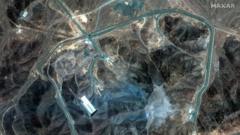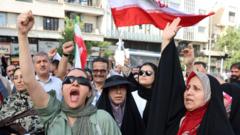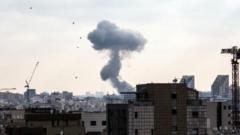A recent analysis of satellite images indicates that the U.S. targeted ventilation shafts at Iran's Fordo nuclear site. Experts have noted that these shafts were likely seen as vulnerable by U.S. intelligence, which led to an overnight airstrike involving significant munitions. Damage assessments continue, with varying reports on the extent of the destruction.
U.S. Targets Iran's Fordo Facility: Satellite Evidence of Attack Unfolds

U.S. Targets Iran's Fordo Facility: Satellite Evidence of Attack Unfolds
Satellite imagery reveals the strategic locations targeted during the U.S. airstrike on Iran's Fordo nuclear facility, including possible ventilation shafts.
June 22, 2025 — Recent satellite images analyzed following the U.S. airstrike on Iran’s underground nuclear enrichment facility at Fordo show evidence of targeted strikes at significant locations, particularly at what may have been ventilation shafts. These structures, which were observable during the facility’s early operational stages in 2009, had disappeared by 2011, potentially having been buried as construction progressed.
Mark Fitzpatrick, a nuclear expert at the International Institute for Strategic Studies, explained that hitting a ventilation shaft can compromise the structure’s integrity. A U.S. official confirmed that six B-2 bombers dropped a dozen 30,000-pound bunker buster bombs on the site, highlighting these shafts as likely the most vulnerable points of the facility.
Despite aggressive claims by President Trump about obliterating Iran's nuclear operations, initial assessments from U.S. and Israeli military sources suggest the facility sustained significant damage rather than complete destruction. Damage evaluations are still ongoing, as the situation remains complex. Joseph Rodgers from the Center for Strategic and International Studies pointed out that targeting such structures appeared well-informed, likely indicating U.S. intelligence had identified them as existing weaknesses.
Imagery from Maxar Technologies revealed debris spread throughout the facility, yet most support structures remained intact, suggesting a focus on undermining the underground aspects of the facility rather than disabling its supporting infrastructure.
In the days leading up to the attack, satellite images displayed unusual activity near the entrance tunnels, leading experts to hypothesize that Iran may have attempted to fortify the site, as seen in the presence of trucks and equipment within the vicinity. Observations indicated the tunnel entrances were filled with dirt post-strike, likely as a protective measure in anticipation of airstrikes.
As the world follows these developments, the situation at Fordo continues to evolve, and further intelligence gathering will be crucial in understanding the full ramifications of the U.S.’s military actions.
Mark Fitzpatrick, a nuclear expert at the International Institute for Strategic Studies, explained that hitting a ventilation shaft can compromise the structure’s integrity. A U.S. official confirmed that six B-2 bombers dropped a dozen 30,000-pound bunker buster bombs on the site, highlighting these shafts as likely the most vulnerable points of the facility.
Despite aggressive claims by President Trump about obliterating Iran's nuclear operations, initial assessments from U.S. and Israeli military sources suggest the facility sustained significant damage rather than complete destruction. Damage evaluations are still ongoing, as the situation remains complex. Joseph Rodgers from the Center for Strategic and International Studies pointed out that targeting such structures appeared well-informed, likely indicating U.S. intelligence had identified them as existing weaknesses.
Imagery from Maxar Technologies revealed debris spread throughout the facility, yet most support structures remained intact, suggesting a focus on undermining the underground aspects of the facility rather than disabling its supporting infrastructure.
In the days leading up to the attack, satellite images displayed unusual activity near the entrance tunnels, leading experts to hypothesize that Iran may have attempted to fortify the site, as seen in the presence of trucks and equipment within the vicinity. Observations indicated the tunnel entrances were filled with dirt post-strike, likely as a protective measure in anticipation of airstrikes.
As the world follows these developments, the situation at Fordo continues to evolve, and further intelligence gathering will be crucial in understanding the full ramifications of the U.S.’s military actions.





















